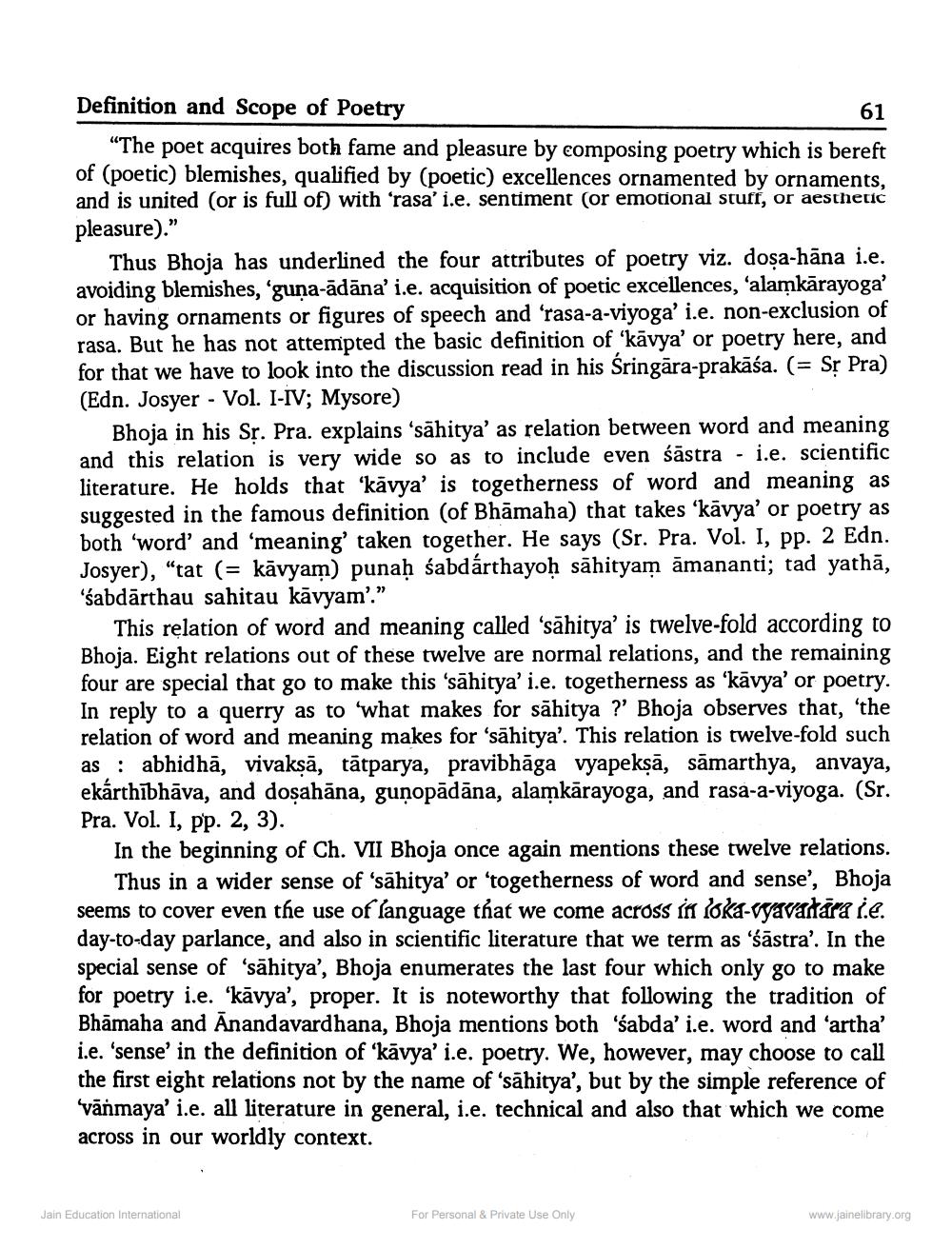________________
Definition and Scope of Poetry
61
"The poet acquires both fame and pleasure by composing poetry which is bereft of (poetic) blemishes, qualified by (poetic) excellences ornamented by ornaments, and is united (or is full of) with 'rasa' i.e. sentiment (or emotional stuff, or aesthetic pleasure)."
Thus Bhoja has underlined the four attributes of poetry viz. doșa-hāna i.e. avoiding blemishes, 'guna-ādāna' i.e. acquisition of poetic excellences, 'alamkarayoga' or having ornaments or figures of speech and 'rasa-a-viyoga' i.e. non-exclusion of rasa. But he has not attempted the basic definition of 'kavya' or poetry here, and for that we have to look into the discussion read in his Śringāra-prakāśa. (= Sr Pra) (Edn. Josyer Vol. I-IV; Mysore)
-
Bhoja in his Sr. Pra. explains 'sahitya' as relation between word and meaning and this relation is very wide so as to include even sastra i.e. scientific literature. He holds that 'kavya' is togetherness of word and meaning as suggested in the famous definition (of Bhamaha) that takes 'kāvya' or poetry as both 'word' and 'meaning' taken together. He says (Sr. Pra. Vol. I, pp. 2 Edn. Josyer), "tat (= kavyam) punaḥ śabdárthayoḥ sahityam amananti; tad yathā, 'sabdarthau sahitau kāvyam'."
This relation of word and meaning called 'sahitya' is twelve-fold according to Bhoja. Eight relations out of these twelve are normal relations, and the remaining four are special that go to make this 'sahitya' i.e. togetherness as 'kavya' or poetry. In reply to a querry as to 'what makes for sahitya ?' Bhoja observes that, 'the relation of word and meaning makes for 'sahitya'. This relation is twelve-fold such as : abhidha, vivakṣā, tātparya, pravibhāga vyapekṣā, sāmarthya, anvaya, ekárthibhāva, and doṣahāna, guṇopādāna, alamkārayoga, and rasa-a-viyoga. (Sr. Pra. Vol. I, pp. 2, 3).
In the beginning of Ch. VII Bhoja once again mentions these twelve relations. Thus in a wider sense of 'sahitya' or 'togetherness of word and sense', Bhoja seems to cover even the use of language that we come across in loka-vyavakara i.e. day-to-day parlance, and also in scientific literature that we term as 'sastra'. In the special sense of 'sahitya', Bhoja enumerates the last four which only go to make for poetry i.e. 'kavya', proper. It is noteworthy that following the tradition of Bhāmaha and Anandavardhana, Bhoja mentions both 'sabda' i.e. word and 'artha' i.e. 'sense' in the definition of 'kavya' i.e. poetry. We, however, may choose to call the first eight relations not by the name of 'sahitya', but by the simple reference of 'vānmaya' i.e. all literature in general, i.e. technical and also that which we come across in our worldly context.
Jain Education International
For Personal & Private Use Only
www.jainelibrary.org




